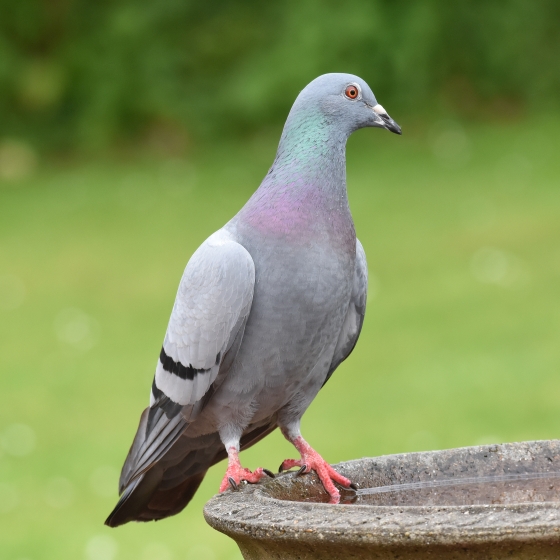Rock Dove

Introduction
If you were searching forFeral Pigeon you have been redirected to our Rock Dove page because this species is the ancestor of the Feral Pigeon.
- You can find information about both Rock Doves and Feral Pigeons on this page.
- You can learn more about both birds in our blog,Wild Rock Doves: solving a genetic enigma.
A deep-red eye, pale-grey plumage, two black wingbars and a white rump make the Rock Dove a beautiful bird.
The Rock Dove is the ancestor of the Feral Pigeon, but truly wild birds occupy a very different setting to their urban cousins. Wild Rock Doves are confined to our northern rocky coasts and islands and nest in sea caves and on steep cliff ledges, whilst Feral Pigeons use a range of human structures, from windowsills to the underside of bridges.
Wild Rock Doves are ringed as part of the Ringing Scheme, results from which reveal that they can live to over seven years of age and, unlike their racing relatives, rarely move very far.

Key Stats
Identification
ID Videos
This section features BTO training videos headlining this species, or featuring it as a potential confusion species.
Pigeons
Songs and Calls
Song:
Call:
Status and Trends
Conservation Status
Population Change
Pure Rock Doves have a very limited distribution, thought to be restricted to remote coastlines of northern and western Scotland and northern Ireland; across the rest of the UK, Feral Pigeons are widespread, although absent from many upland areas [Balmer et al. 2013]. The specoes is poorly monitored, but long-term trend from BBS data shows a moderate, but not statistically significant decline.
Distribution
Pure Rock Doves are thought to be restricted to remote coastlines of north and west Scotland and north, west and south Ireland. Elsewhere, birds resembling Rock Doves occur in many Feral Pigeon flocks. Owing to the difficulty of assigning such individuals to each form the maps here combine Rock Doves and Feral Pigeons. The resulting maps show this resident species to be widespread in Britain, though largely absent from the uplands of central Wales, northwest England, the Southern Uplands and Scottish Highlands. In Ireland it is found mostly in the east and south, and is absent from large parts of the midlands.
Occupied 10-km squares in UK
or view it on Bird Atlas Mapstore.
or view it on Bird Atlas Mapstore.
European Distribution Map
Distribution Change
Change in occupied 10-km squares in the UK
or view it on Bird Atlas Mapstore.
or view it on Bird Atlas Mapstore.
Seasonality
Rock Doves (and Feral Pigeons) are recorded throughout the year.
Weekly pattern of occurrence
The graph shows when the species is present in the UK, with taller bars indicating a higher likelihood of encountering the species in appropriate regions and habitats.

Movement
Britain & Ireland movement
Foreign locations of birds ringed or recovered in Britain & Ireland
Dots show the foreign destinations of birds ringed in Britain & Ireland, and the origins of birds ringed overseas that were subsequently recaptured, resighted or found dead in Britain & Ireland. Dot colours indicate the time of year that the species was present at the location.
- Winter (Nov-Feb)
- Spring (Mar-Apr)
- Summer (May-Jul)
- Autumn (Aug-Oct)

Biology
Productivity and Nesting
Nesting timing
Egg measurements
Clutch Size
Survival and Longevity
Survival is shown as the proportion of birds surviving from one year to the next and is derived from bird ringing data. It can also be used to estimate how long birds typically live.
View number ringed each year in the Online Ringing Report.
lifespan
Survival of adults
Survival of juveniles
Biometrics
Wing length and body weights are from live birds (source).
Wing length
Body weight
Ring Size
Classification, names and codes
Classification and Codes
- Order: Columbiformes
- Family: Columbidae
- Scientific name: Columba livia
- Authority: JF Gmelin, 1789
- BTO 2-letter code: DV
- BTO 5-letter code: ROCDO
- Euring code number: 6650
Alternate species names
- Catalan: colom roquer
- Czech: holub skalní
- Danish: Klippedue
- Dutch: Rotsduif
- Estonian: kaljutuvi
- Finnish: kalliokyyhky (kesykyyhky)
- French: Pigeon biset
- Gaelic: Calman-creige
- German: Felsentaube
- Hungarian: szirti galamb
- Icelandic: Bjargdúfa
- Irish: Colm Aille
- Italian: Piccione selvatico
- Latvian: klinšu balodis
- Lithuanian: uolinis karvelis
- Norwegian: Klippedue (Bydue)
- Polish: golab skalny
- Portuguese: pombo-doméstico / pombo-das-rochas
- Slovak: holub divý
- Slovenian: skalni golob
- Spanish: Paloma bravía
- Swedish: klippduva
- Welsh: Colomen y Graig

